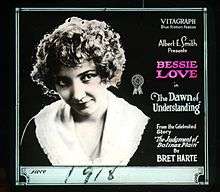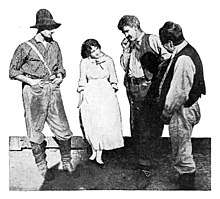The Dawn of Understanding
The Dawn of Understanding is a lost[6] 1918 American silent Western comedy film produced by The Vitagraph Company of America and directed by David Smith. It stars Bessie Love in the first film of her nine-film contract with Vitagraph.[7] It is based on the short story "The Judgement of Bolinas Plain" by 19th-century Western writer Bret Harte.[8][9][10]
| The Dawn of Understanding | |
|---|---|
 Lantern slide | |
| Directed by | David Smith |
| Written by | Edward J. Montagne (scenario) |
| Based on | "The Judgement of Bolinas Plain" by Bret Harte[1][2] |
| Starring | Bessie Love John Gilbert |
| Cinematography |
|
Production company | Vitagraph Company of America |
| Distributed by | General Vitagraph, Incorporated |
Release date |
|
Running time | 50 minutes; 5 reels |
| Country | United States |
| Language | Silent (English intertitles) |
Plot
.jpg)
In 1849, the Silas Prescott (Williams) and his family travel west to the California gold fields by prairie schooner. Along the difficult journey, his wife dies, and they bury her near Ira Beasley's (Gilbert) ranch. Beasley becomes enamored of Prescott's daughter Sue (Love), and she stays behind to be Beasley's wife. Their marriage is one of mutual indifference, and Sue grows to resent Beasley.
When the circus comes to town, Sue falls for acrobat Jim Wynd (Glendon). Jim shoots a man in a brawl, and hides in the Beasley's barn. Sue discovers him there, and they get acquainted, to the point of planning to elope. Sue empties her husband's gun so that she and Jim can escape more easily.
A mob discovers that Jim is hiding in the barn, surrounding it. Ira, not knowing what is happening, shoots at the sheriff at the same time that Jim does. When Ira is arrested and put on trial for shooting the sheriff, Sue confesses that her husband could not have killed him because his gun was not loaded. Jim is convicted of his crimes.[11][12][13][14]
Cast

- Bessie Love as Sue Prescott
- George A. Williams as Silas Prescott
- John Gilbert as Ira Beasley
- J. Frank Glendon as Jim Wynd
- George Kunkel as Sheriff Jack Scott
- Jacob Abrams as Parson Davies
- Dorothea Wolbert as Mrs. Prescott[11][12]
Release and reception
Reviews were generally positive,[17] and it was generally commercially successful.[17][18][19]
The popularity of the film was seen as a rise in the stardom of its star, Bessie Love.[20] Upon its release, it was shown in some theaters with The Enchanted Barn, which also starred Love, as "Bessie Love Day."[21]
References
- "Recent Motion Pictures Based on Books". The Publisher's Weekly. December 14, 1918. p. 1937.
- "Vitagraph Star Series". The Moving Picture World. January 18, 1919. p. 266.
- Love, Bessie (1977). From Hollywood with Love: An Autobiography of Bessie Love. London: Elm Tree Books. p. 149. OCLC 734075937.
- "Work of Cameramen". Wid's Year Book 1919. p. 351.
- "List of Current Film Release Dates". The Moving Picture World. January 4, 1919. p. 124.
- The Library of Congress American Silent Feature Film Survival Catalog: The Dawn of Understanding
- "Vitagraph". Motion Picture News. November 30, 1918. p. 3146.
- Hanson, Patricia King, ed. (1988). The American Film Institute Catalog of Motion Pictures Produced in the United States: Feature Films 1911–1920. Berkeley, California: University of California Press. ISBN 978-0-520-06301-3.
- Bennett, Carl (February 26, 2010). "Progressive Silent Film List: The Dawn of Understanding". Silent Era.
- The AFI Catalog of Feature Films: The Dawn of Understanding
- Harrison, P.S. (December 7, 1918). "'The Dawn of Understanding'—Vitagraph". Motion Picture News. pp. 3424–5.
- "Advertising Aids for Busy Managers". The Moving Picture World. November 23, 1918. p. 860.
- Langman, Larry (1992). A Guide to Silent Westerns. Greenwood Publishing Group. p. 108. ISBN 978-0-313-27858-7.
- Weitzel, Edward (December 14, 1918). "Critical Reviews and Comments". The Moving Picture World. p. 1247.
- Jessen, J.C. (September 21, 1918). "In and Out of West Coast Studios". Motion Picture News. p. 1924.
- Jessen, J.C. (October 19, 1918). "In and Out of West Coast Studios". Motion Picture News. p. 2608.
- "Index to Complete Plan Book and Exhibitors' Box Office Reports". Motion Picture News. January 4, 1919. p. 161.
- "News of the Week in San Francisco". Motion Picture News. Vol. 19 no. 8. February 22, 1919. p. 7.
- "What the Picture Did for Me". Exhibitors Herald and Motography. Vol. 8 no. 14. March 29, 1919. p. 46.
- "Bookings Indicate Rise of Bessie Love". Motion Picture News. April 26, 1919. p. 2669.
- "Live News from the Producers". Motion Picture News. March 15, 1919. p. 1640.
External links
| Wikimedia Commons has media related to The Dawn of Understanding. |
- The Dawn of Understanding on IMDb
- The Dawn of Understanding at AllMovie
- The Dawn of Understanding at the British Film Institute
- The Dawn of Understanding at the American Film Institute Catalog
- The Dawn of Understanding at the TCM Movie Database